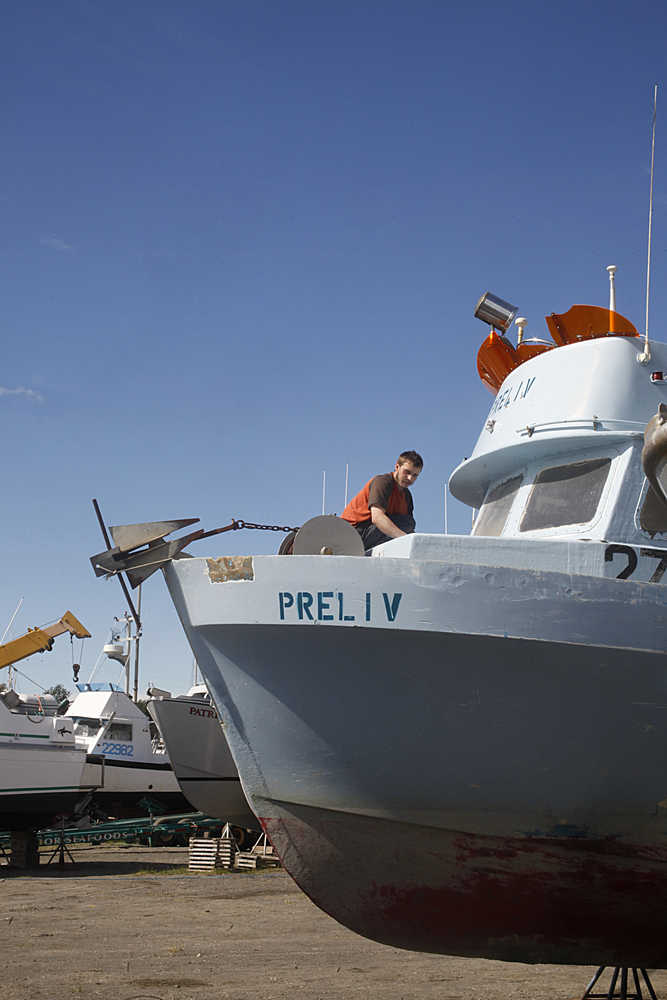The Snug Harbor Seafoods receiving dock was bustling Thursday, though not with commercial drift gillnetters bringing in volumes of sockeye salmon from the season’s first opener; rather with captains and crews who spent the afternoon putting the finishing touches on their boats, readying for the upcoming fishing season.
Typically, the first opener of the commercial season is slow, said Fish and Game managers and fishermen on the dock, though the banner run of Kasilof River sockeye lured some into the water Thursday for the 12-hour Cook Inlet-wide opening. In 2013, 60 boats went out on the first commercial drift opener and caught about 3,500 fish, according to Fish and Game catch data.
Several dozen people spent the sunny afternoon working on their boats, running new crew through equipment and boat operations or, like Paul Usoltseff, doing minor repairs before putting into the water.
“I will be going into the water on Wednesday,” Uloltseff said. “I’ll fish Thursday’s opener.”
The commercial drift gillnetting fleet in the Cook Inlet is scheduled to fish regular 12-hour openers on Mondays and Thursdays through July 8, before regulations change their fishing period time and the areas where they are allowed to fish.
Roland Maw, drift gillnet fisher and executive director of the United Cook Inlet Drift Association, said he had skipped fishing the first opening day of the season and was instead getting ready to go fishing for halibut near Kodiak.
“It’s pretty slow,” he said. “I know two or three boats went out but they didn’t get many, less than 20.”
Despite a Wednesday evening storm, Thursday morning was relatively calm and that weather extended into the afternoon — though the blue sky was punctuated with several heavy, dark clouds.
Catches, primarily of the sockeye salmon targeted by the fleet, will pick up as the season progresses, said Aaron Dupuis, assistant area management biologist in the commercial division of Fish and Game.
This early in the season, drift gillnet fishers will primarily be catching sockeye, or red, salmon headed to the Kasilof River — a run that is performing well above average for this time of year, according to Fish and Game fish counts on the river.
By midnight Thursday 34,500 fish had passed the sonar on the Kasilof River and ten hours later 40,000 had passed through — more than twice as many fish as were counted last year at the same time.
Dupuis said the sockeye salmon run was the second largest since 1983, but the large numbers did not imply a run that was larger than usual; rather the run could be early and taper off sooner than last year’s did.
When compared to sockeye salmon runs in Kodiak and on the Copper River, Dupuis said the run could be both early and strong.
“It’s too early to tell,” he said. “We’re two percent through the run, so we’re all kind of guessing.”
Still, it is likely the river will hit the 50,000 mark by Friday if current trends continue, meaning area managers could open the set gillnet fishery in the Kasilof section of the East Side Setnet Fishery.
Both Dupuis and area management biologist Pat Shields said Fish and Game would not be opening the set gillnet fishery as fish in the early run of Kenai River king salmon, which swim through the same area as Kasilof-bound sockeye, are still vulnerable to harvest.
“We’re going to wait and evaluate king salmon data for a couple more days,” Shields said.
Typically, the set gillnet fleet has a better chance of harvesting Kasilof-bound sockeye salmon than the drift gillnet fleet.
“Kasilof sockeye are very beach oriented and they come up the beaches. They’re not available to the drifters very well,” Shields said.
Last year, the commercial fleet was under similar restrictions due to low king salmon runs. More than 489,000 sockeye salmon escaped into the Kasilof River — well above the upper end river’s sustainable escapement goal range of 160,000 to 390,000.
Rashah McChesney can be reached at rashah.mcchesney@peninsulaclarion.com

